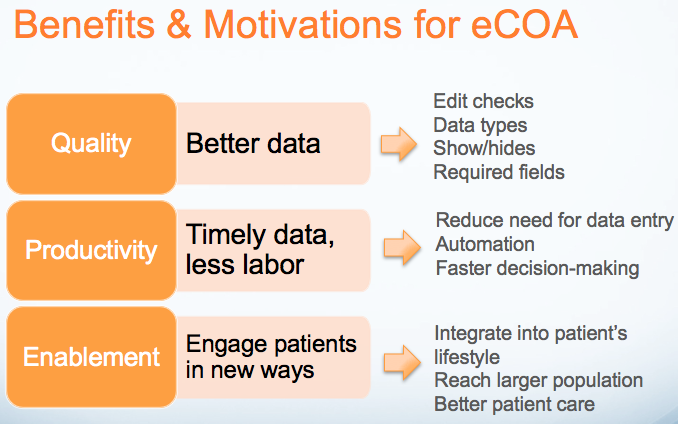I recently delivered a webinar titled “Getting Started with eCOA/ePRO,” in which roughly a third of attendees polled cited expense as the number one reason that has prevented them from adopting an ePRO solution. So what does ePRO really cost? Is it worth it? Here I strive to provide a basic, high-level framework for thinking about the return on investment ROI of eCOA vs. paper.
Let’s start by taking a look at the costs that are unique to each approach.
Paper
In a traditional paper based model, you are incurring costs that stem from printing, mailing, data entry, and data cleaning. These are all expenses than can be estimated with a fair degree of accuracy, with the cost of data entry being the most significant of these. To estimate the cost of data entry, see how long it takes to key in a subject completed paper casebook, multiply this by your cost of labor (don’t forget to include overhead!).
ePRO
The cost side for ePRO is similarly straightforward, but the expense elements are different. You’re either building an ePRO system (which will almost carry a highly unpredictable cost) of buying one (much more predictable cost). Assuming you’re buying, here are the costs you may expect to incur:
· License
· Hosting
· Training and support
· Professional services (e.g. study configuration)
· Devices
You should evaluate whether your study and selected ePRO system will allow for patients to use their own devices, or if you will need to provision devices (or some mix thereof). The cost of provisioning devices, especially for a global study can be significant—in addition to the costs of the devices themselves, you will need to consider the costs of data plans, and logistics associated with supporting the devices. I’m a big fan of BYOD (bring your own device) but, depending on the study, it may not be feasible to utilize while maintaining scientific validity of data collected.
Once you’ve mapped out your costs of each route, you can begin to weigh these against the benefits of going eCOA.
Paper vs. eCOA
When you boil it down, people employ ePRO/eCOA to maximize data quality, increase productivity, and/or enable new capabilities that help answer their research questions. ePRO is e-source, so you don’t have worry about administering a paper data entry process. Depending on the study, the cost savings from this alone might justify ePRO.
There are some additional benefits ePRO offers over paper that may be harder to quantify, but nonetheless very real. For example, there are clear data quality benefits to ePRO. The electronic system can ensure a minimum standard of data quality through edit checks and enforced data structures. ePRO data will always be cleaner than the same data captured on paper.

The use of an ePRO system also allows you to know for sure when the data were recorded. For instance, patients can be reminded automatically when their diaries are overdue, and you now only have much stronger assurances that data were collected at the appropriate time (vs paper), you can also more easily monitor the study progress.
Bypassing manual data entry and having the system provide notifications to subjects to ensure data are captured in a timely way might allow for faster and better in-study decision making and even may accelerate study closeout. Also, an increasing amount of evidence exists that mobile-based messaging and communication strategies help increase patient engagement and treatment adherence. And of course, not having to deal with a stack of paper during a site visit might allow the clinician’s interaction with the patient to be higher quality.
Quantifying the benefits of all of these things can be tough, but start with those which are most quantifiable and see if those items alone these alone provide a compelling ROI (from my experience they often do). Then the less tangible benefits become gravy to the ROI argument. When modeling costs over time and a pay-back period, keep in mind that ePRO will typically carry a higher upfront cost than paper, with the cost saving benefits realized downstream over time. With today’s technologies, even most smaller studies should be able to realize a positive payback.
Naturally, there may be additional ROI factors to consider which are specific to your situation. If you have particular thoughts, questions, or experiences on this topic I encourage you to add a comment to this post.

